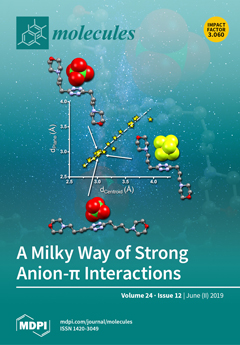We report a new one-pot synthesis of 2-trifluoromethylated/2-perfluoroalkylated
N-aryl-substituted pyridiniums, 5,6,7,8-tetrahydroquinoliniums and 6,7,8,9-tetrahydro-5
H-cyclohepta[
b]-pyridinium compounds starting from an activated β-dicarbonyl analogue (here a perfluoro-alkylated gem-iodoacetoxy derivative), an aromatic amine and a (cyclic or acyclic) ketone. The key step of
[...] Read more.
We report a new one-pot synthesis of 2-trifluoromethylated/2-perfluoroalkylated
N-aryl-substituted pyridiniums, 5,6,7,8-tetrahydroquinoliniums and 6,7,8,9-tetrahydro-5
H-cyclohepta[
b]-pyridinium compounds starting from an activated β-dicarbonyl analogue (here a perfluoro-alkylated gem-iodoacetoxy derivative), an aromatic amine and a (cyclic or acyclic) ketone. The key step of this multicomponent reaction, involves the formation of a 3-perfluoroalkyl-
N,
N’-diaryl-1,5-diazapentadiene intermediate, various examples of which were isolated and characterized for the first time, together with investigation of their reactivity. We propose a mechanism involving a concurrent inverse electron demand Diels-Alder or Aza-Robinson cascade cyclisation, followed by a bis-de-anilino-elimination. Noteworthy, a
meta-methoxy substituent on the aniline directs the reaction towards a 2-perfluoroalkyl-7-methoxyquinoline, resulting from the direct cyclization of the diazapentadiene intermediate, instead of pyridinium formation. This is the first evidence of synthesis of pyridinium derivatives from activated β-dicarbonyls, ketones, and an aromatic amine, the structures of which (both reactants and products) being analogous to species involved in biological systems, especially upon neurodegenerative diseases such as Parkinson’s. Beyond suggesting chemical/biochemical analogies, we thus hope to outline new research directions for understanding the mechanism of in vivo formation of pyridiniums, hence possible pharmaceutical strategies to better monitor, control or prevent it.
Full article






